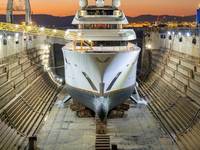Shaft Vibration Eliminated With Vesconite Hilube
After replacing the all-rubber cutlass bearing of his new Jeanneau Sun Fast 35 Tide The Knot two times in seven years, Robert Metzen sought an alternative. A fellow sailor told him about his positive experience with Hilube as a rudder bearing. Shortly after contacting Leandro Panzini from Vesconite distributor VesArg, Metzen had a state-of-the-art polymer bearing installed.
At 2,300 rpm, a sailboat engine will spin its propeller shaft a million times in less than eight hours. Cutlass bearing materials such as rubber and bronze wear prematurely. This creates excessive shuddering and can seriously damage an expensive shaft, log or strut. Metzen experienced severe vibration at 2,900-3,000 rpm.
Jeanneau recommends replacing the cutlass bearing annually—a time-consuming and expensive proposition. Their all-rubber part simply did not have the longevity and reliability Metzen required.
Vesconite Hilube offers a wear life more than 10 times that of bronze. Internally lubricated, it offers ultra-low friction properties, even in dirty or silty water. Dimensionally stable, it has exceptional load strength and won't soften or swell in water—increasing the chance of wear-related vibration—making it the ideal cutlass bearing material.
The innovative polymer is easily machined to +/-0.001"; tolerances for a 1.5" shaft are typically .004" to .009". With a shell and liner, rubber bearings have limited installation options. In contrast, Vesconite Hilube is easily fitted with set screws or adhesive, or pressed into place. It's available as raw stock or precision-machined parts.
Vesconite is no stranger to performance sailing. It's used as a bearing material in a wide range of applications such as blocks and sliding cars, rudders, stern tubes and shafts. It's the preferred polymer for foil and daggerboard trunks by builders such as Gunboat and HH Catamarans, and was used for that purpose on an America's Cup boat.





